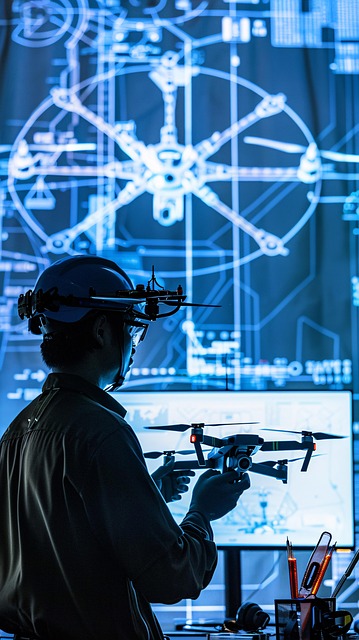Unmanned Aerial Vehicle (UAV) security offers scalable, efficient, and versatile solutions for modern safety and surveillance operations. These advanced drones, equipped with cutting-edge sensors and cameras, enhance situational awareness, facilitate inspections, and enable quicker incident response. Ideal for large events, border patrols, infrastructure monitoring, and post-disaster assessments, UAVs provide comprehensive coverage and reduce risks to human personnel. Scalable drone services require robust communication systems, encryption techniques, adherence to regulations, flight planning, risk assessment, regular maintenance, and advanced sensors for reliable operations across diverse sectors like border surveillance, event management, and infrastructure inspections.
“Unmanned Aerial Vehicles (UAVs), or drones, are transforming security operations across industries. This comprehensive guide explores the potential of scalable drone services for small to large-scale security deployments. We delve into the benefits of integrating drones, from enhanced surveillance and rapid response to cost-effective monitoring. Understanding UAV security involves examining technical considerations and best practices to ensure safe and efficient operations. Through real-world case studies, we showcase successful UAV implementations, highlighting their versatility and impact on modern security measures.”
Understanding Unmanned Aerial Vehicle (UAV) Security: A Comprehensive Overview
Unmanned Aerial Vehicle (UAV) security has emerged as a critical aspect in modern safety and surveillance operations, offering unprecedented capabilities for monitoring and protection. These advanced drones, equipped with cutting-edge sensors and cameras, provide a scalable and efficient solution for various security challenges. By leveraging UAV technology, organizations can enhance their situational awareness, conduct thorough inspections, and respond to incidents with greater agility.
The integration of unmanned aerial vehicles into security protocols brings numerous benefits, including improved accessibility in hard-to-reach areas, real-time data acquisition, and reduced risk to human personnel. With their ability to fly at various altitudes and cover extensive ground, UAVs ensure comprehensive security operations. Moreover, these drones can be deployed for large-scale events, border patrols, infrastructure monitoring, and post-disaster assessments, providing a versatile toolset for security professionals.
Benefits of Integrating Drones into Security Operations for Various Sizes of Organizations
Integrating drones into security operations offers significant advantages for organizations of all sizes, from small businesses to large enterprises. For smaller entities, unmanned aerial vehicle (UAV) security provides an efficient and cost-effective solution for monitoring perimeters, detecting intrusions, and enhancing overall safety. Drones can cover vast areas swiftly, ensuring quick response times during potential threats. Their compact size allows for easy deployment in tight spaces, making them ideal for various industrial and commercial settings.
On the other hand, larger organizations benefit from drones’ scalability and versatility. They can be utilized for comprehensive security assessments, providing bird’s-eye views of extensive facilities or remote locations. Drones equipped with advanced sensors enable real-time data collection and analysis, facilitating proactive risk management. Moreover, UAVs can augment existing security measures by performing reconnaissance missions, offering a cost-efficient alternative to traditional surveillance methods.
Scalability in Drone Services: Adapting to Different Deployment Scenarios
Drone services for security operations must be adaptable and scalable to cater to a wide range of deployment scenarios, from small-scale patrols to large-area surveillance. Unmanned Aerial Vehicles (UAVs) equipped with advanced sensors can provide valuable intelligence in urban environments, remote areas, or disaster zones, offering significant advantages over traditional ground-based security methods.
Scalability in drone services allows for flexible deployment based on the needs of the operation. For smaller tasks, a single drone may suffice, providing real-time aerial imagery and data to security personnel. In contrast, larger-scale operations might require multiple drones working in conjunction, covering extensive areas and coordinating with ground teams for comprehensive security management. This adaptability ensures that UAVs can be effectively utilized in various contexts, enhancing overall operational efficiency and effectiveness in the field of security.
Technical Considerations and Best Practices for Secure Drone Operations
When implementing scalable drone services for security operations, several technical considerations and best practices must be followed to ensure safe and effective deployments. Unmanned Aerial Vehicle (UAV) security requires robust communication systems to maintain real-time data transmission between the drone, ground control station, and relevant personnel. Encryption techniques should be employed to safeguard sensitive information from potential cyber threats.
Additionally, flight planning and risk assessment are paramount. Operations should adhere to local regulations and no-fly zones to avoid legal issues and collision risks. Regular maintenance checks and system redundancies are essential to minimize downtime and ensure the reliability of critical security operations. Employing advanced sensors, such as high-resolution cameras, thermal imaging, and LiDAR, enhances the drone’s capabilities in various lighting conditions and terrain types for comprehensive security monitoring.
Case Studies: Success Stories of UAV Implementation in Diverse Security Settings
Unmanned Aerial Vehicle (UAV) security has proven its worth in various real-world scenarios, offering innovative and efficient solutions to traditional security challenges. Numerous case studies highlight successful implementations across diverse sectors, showcasing the versatility of UAV technology.
For instance, in remote border surveillance, UAVs equipped with high-resolution cameras and thermal imaging have been instrumental in identifying illegal crossings and monitoring suspicious activities. These drones provide a cost-effective alternative to ground patrols, offering a comprehensive aerial view while enhancing operational reach. Another success story involves their deployment in large-scale events like music festivals or sports competitions, where they assist in crowd control and security management by providing real-time video feeds of vast areas. Additionally, UAVs have been utilized in urban settings for infrastructure inspections, such as power lines and bridges, ensuring safety and efficiency in potentially hazardous tasks.
The integration of unmanned aerial vehicle (UAV) security into operations across various sectors offers a scalable, efficient, and cost-effective solution for enhancing surveillance and response capabilities. By understanding the technical aspects, best practices, and diverse case studies presented here, organizations can effectively leverage drone services to meet their unique security needs—whether on a small or large scale. This technology promises to revolutionize security operations, providing comprehensive coverage with enhanced agility, making it an indispensable tool in today’s dynamic security landscape.
